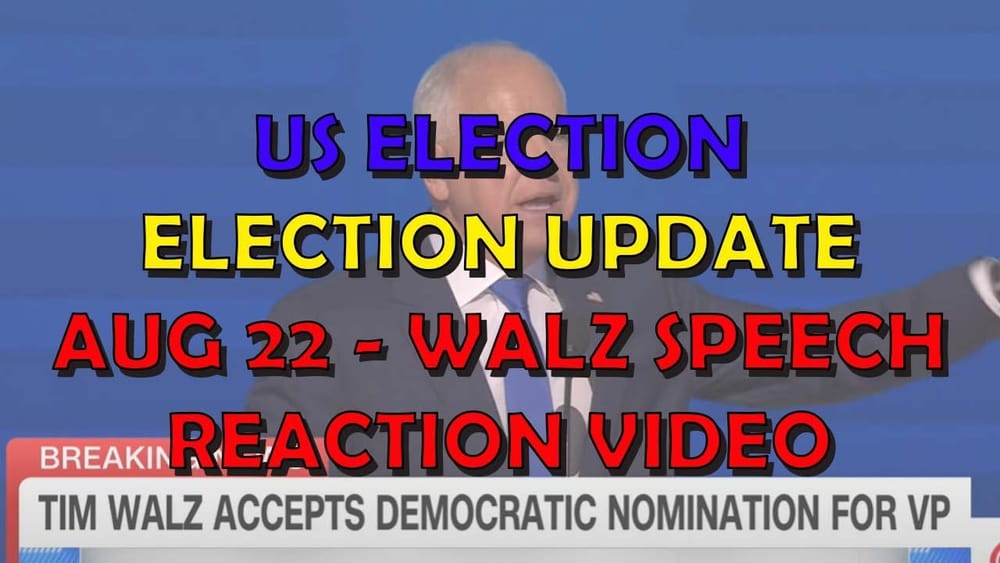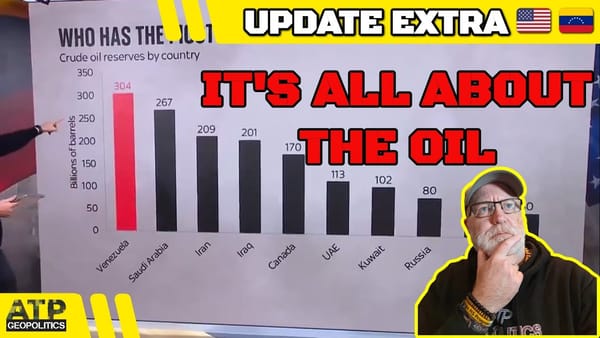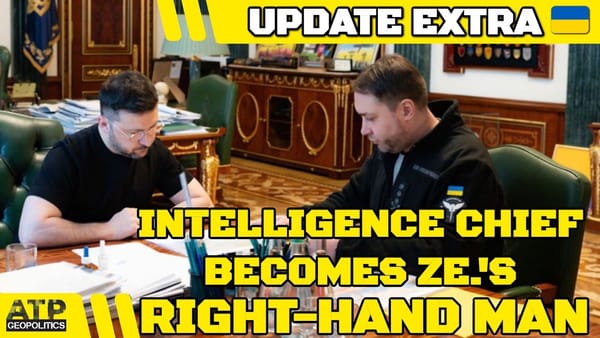US Politics Election Extra: Tim Walz DNC Speech Reaction Video
Table of Contents 📖
"When we fight, we win."
Hello Team
🎦 00:00-03:40⏩
Jonathan welcomes viewers to his US election special, a reaction video to Tim Walz, the Democratic nominee for Vice President. He highlights the importance of understanding how political messages resonate with different demographics and how strategies differ between the Democrats and Republicans. He notes that the Republican campaign seems to be focused solely on their base, while the Democrats are strategizing for broader appeal. He states that the Republicans are playing to their base and not thinking beyond it, and that their strategy has a ceiling, meaning they will not win the election without expanding their reach.
Return to top⤴️
Tim Walz’s Speech: Introduction
🎦 03:40-04:46⏩
Jonathan begins the analysis of Tim Walz's speech by explaining that Walz is not a practiced teleprompter speaker and is not used to speaking in front of large crowds. He acknowledges that this makes his performance all the more impressive. He then introduces Walz's speech to the viewers, emphasizing that he will be interrupting it to offer his commentary and analysis.
Return to top⤴️
Family Man
🎦 04:46-06:48⏩
The video starts with a shot of Walz's family, conveying an immediate impression of him as a “family man.” This initial message is underscored by the emotion evident in his family's reaction to his introduction, suggesting a loved and adored person. Jonathan also highlights the subtle but significant moment when Walz thanks Kamala Harris for “inviting” him to be part of the campaign, suggesting that she is the one who makes the decisions.
Return to top⤴️
The Servant King
🎦 06:48-09:46⏩
Jonathan discusses the theme of "service" in Walz's speech, contrasting it with Donald Trump's perceived lack of service to the American people. He argues that Trump's leadership style is more aligned with an authoritarian or dictatorial approach, while Walz's emphasizes serving the people. He further contrasts this with the "servant king" concept, where the leader serves the people rather than ruling over them. He also mentions Trump's recent comment regarding forgiveness, suggesting that Trump sees himself as a perfect ruler rather than a servant. He suggests that Walz's message resonates with a different style of leadership, one that values serving the people over ruling them.
Return to top⤴️
Paying Respect
🎦 09:46-10:45⏩
Jonathan notes Walz's gratitude toward Joe Biden, recognizing that it is due to Biden's leadership that they have been given this platform. He suggests that this respectful acknowledgment of Biden is a smart move for the Democrats.
Return to top⤴️
Democratic Patriotism
🎦 10:45-11:24⏩
Jonathan highlights the shift in the Democratic convention's rhetoric toward a more patriotic and nationalist approach, something typically associated with the Republicans. He mentions a comment by Tim Miller on MSNBC where he suggested that the Democrats are now "giving permission" for their supporters to express national pride and patriotism. He concludes that this shift in rhetoric will be a key part of Walz's strategy to expand the Democratic base.
Return to top⤴️
Joy Over Fear
🎦 11:24-12:40⏩
Jonathan focuses on the prominent theme of "joy" in Walz's speech, a stark contrast to the Republican campaign's use of fear and division. He argues that the Democrats are aiming for a more positive and uplifting message, emphasizing unity and inclusivity, which he believes is more effective than the Republicans' fear-based approach. He suggests that joy is more infectious than fear, and that this positive approach can resonate with a wider audience.
Return to top⤴️
Roll Call Comparison
🎦 12:40-14:45⏩
Jonathan compares the Democratic and Republican conventions' roll call ceremonies, highlighting the positive and celebratory atmosphere of the Democrats versus the more somber tone of the Republicans. He describes the Democrats' use of DJ Cassidy and music tailored to each state as a strategic move that created a sense of party and unity. He contrasts this with the Republican roll call, which he describes as "me, me, me" and lacking the same energy and excitement.
Return to top⤴️
Attracting Swing Voters
🎦 14:45-15:38⏩
Jonathan emphasizes the importance of the Democrats' convention atmosphere in attracting undecided voters and young viewers. He suggests that the positive and celebratory tone of the Democrats is likely to be more appealing than the more divisive and negative messages of the Republicans.
Return to top⤴️
Rural Roots
🎦 15:38-16:20⏩
Jonathan highlights Walz's emphasis on his rural roots and his connection to the rural population. He emphasizes the importance of Walz's rural background in appealing to a demographic that is often associated with the Republican party. He argues that by sharing his background as a rural person, Walz is giving permission for rural Americans to identify as Democrats. He suggests that this is a strategic move to expand the Democratic base.
Return to top⤴️
Middle Class Values
🎦 16:20-17:16⏩
Jonathan underlines the importance of Walz's focus on middle class values, contrasting him with Trump and J.D. Vance, who are seen as elites and out of touch with the average American. He emphasizes that Walz's message of being "one of the people" is a powerful tool for building trust and connection with a large segment of the population.
Return to top⤴️
Small Town Unity
🎦 17:16-18:32⏩
Jonathan focuses on Walz's message of community and unity, drawing from his experience growing up in a small town where people of diverse backgrounds lived together. He suggests that Walz is advocating for a united America where people with different ideologies, religions, and sexual orientations can come together and look after one another.
Return to top⤴️
Service and the Military
🎦 18:32-20:57⏩
Jonathan emphasizes Walz's military service as a way to further contrast him with Trump, who avoided the draft, and J.D. Vance. He praises Walz's commitment to service and his dedication to serving his country, both in the military and as a teacher and coach. He connects Walz's commitment to service with the theme of the "servant king" and the idea of a leader who prioritizes the well-being of the people over their own self-interest. He also highlights Walz's discussion of Social Security survivor benefits and the GI Bill, emphasizing his support for social welfare programs that benefit veterans and the middle class.
Return to top⤴️
Sports Analogy
🎦 20:57-22:40⏩
Jonathan continues to use the sports analogy to connect with a large segment of the American population who are sports fans. He suggests that by speaking the language of sports and coaching, Walz is appealing to this demographic, including those who might identify as Republicans. He highlights Walz's emphasis on winning and his vision for a successful America.
Return to top⤴️
Public School Teacher
🎦 22:40-24:41⏩
Jonathan emphasizes Walz's background as a public school teacher, recognizing the universal popularity of teachers in American society. He suggests that by sharing this part of his background, Walz is appealing to a broad audience and building further trust and connection with voters.
Return to top⤴️
Authenticity and Cadence
🎦 24:41-25:13⏩
Jonathan praises Walz's authentic and genuine delivery, contrasting him with politicians like J.D. Vance who are seen as inauthentic and calculated. He argues that Walz's genuine approach is a key part of his appeal and helps him connect with voters on a personal level.
Return to top⤴️
Bipartisan Work
🎦 25:13-26:36⏩
Jonathan highlights Walz's commitment to bipartisan work and his willingness to collaborate with Republicans to get things done. He argues that this is a strategic move to appeal to Republicans and swing voters who are looking for politicians who can work together across the aisle.
Return to top⤴️
Appealing to Republicans
🎦 26:36-26:54⏩
Jonathan points out that Walz is not just appealing to Democrats; he is also using messaging that could resonate with Republicans, such as his focus on cutting taxes and his record of working on rural issues and veteran affairs.
Return to top⤴️
Policies and the Middle Class
🎦 26:54-27:56⏩
Jonathan highlights the Democratic policies that Walz emphasizes, such as cutting taxes for the middle class, paid family leave, affordable housing, and reducing prescription drug costs. He argues that these are policies that could appeal to a broad range of voters, including Republicans and independents. He also notes the shift in the public perception of the Affordable Care Act (Obamacare), which has become more popular over time. He suggests that the Democrats are now capitalizing on this shift in public opinion, highlighting the Affordable Care Act's benefits and distancing it from its controversial past.
Return to top⤴️
Equality of Opportunity
🎦 27:56-29:48⏩
Jonathan analyzes Walz's message regarding ensuring that all children have access to food at school. He emphasizes the importance of providing this basic need to allow children to focus on learning and achieve their potential, arguing that this is about equality of opportunity rather than outcome. He applauds Walz's bold statement about “banishing hunger” from schools, contrasting it with the Republicans' focus on “banning books.” He suggests that Walz is framing the Democrats' approach as a positive force for change, offering real solutions to problems facing the middle class, while the Republicans are focused on cultural wars and divisive issues.
Return to top⤴️
Reproductive Freedom
🎦 29:48-31:50⏩
Jonathan discusses Walz's approach to reproductive rights, emphasizing that the Democrats are framing it as an issue of freedom and personal choice. He argues that the Republicans are trying to restrict this freedom by focusing on abortion, while the Democrats are promoting a broader perspective that encompasses contraception and other reproductive healthcare needs. He suggests that Walz's use of the phrase "reproductive freedom" is a strategic way to appeal to a broader audience and to emphasize the positive aspects of the Democrats' stance. He also highlights the importance of Walz's "mind your own damn business" message, which he suggests is a way of appealing to libertarian-leaning voters and contrasting the Democrats' approach with the Republicans' intrusive policies.
Return to top⤴️
IVF and Fertility Treatments
🎦 31:50-35:31⏩
Jonathan discusses Walz's personal experience with IVF, highlighting its importance in helping families grow. He argues that this is a powerful message that resonates with a core Republican value of being "pro-family." He also underscores the emotional element of his story, including his wife Gwen's experience with infertility, and the birth of their daughter Hope. He suggests that Walz is using his personal story to connect with voters on a deeper level and to appeal to a broader range of values.
Return to top⤴️
Freedom Redefined
🎦 35:31-37:26⏩
Jonathan contrasts the Democrats' and Republicans' interpretations of “freedom.” He suggests that the Republicans often use the term “freedom” to justify corporate interests and government intrusion into personal lives, while the Democrats are promoting a different vision of freedom that emphasizes personal autonomy and the ability to build a better life. He emphasizes the Democrats' focus on issues like healthcare, education, and safety, arguing that these are the true freedoms that matter to everyday Americans.
Return to top⤴️
Gun Control and the Second Amendment
🎦 37:26-39:54⏩
Jonathan analyzes Walz's approach to gun control and the Second Amendment, suggesting that he is offering a balanced perspective that could appeal to both gun rights advocates and those who support stricter gun control measures. He praises Walz's statement that he believes in the Second Amendment but that his first responsibility is to keep children safe. He suggests that this message is effective because it acknowledges the importance of gun rights while also prioritizing the need for safety. He also highlights the importance of Walz's message of responsibility and community, suggesting that these values are crucial in addressing the complex issue of gun violence.
Return to top⤴️
Project 2025
🎦 39:54-42:35⏩
Jonathan discusses Donald Trump and J.D. Vance's “Project 2025,” a detailed plan for their administration. He suggests that the plan is not just a theoretical document but a road map for their future actions if they regain power. He argues that this plan will negatively impact the middle class by increasing their costs, dismantling essential social programs, and restricting personal freedoms.
Return to top⤴️
Contrasting Visions of Service
🎦 42:35-43:21⏩
Jonathan further contrasts the Democrats' and Republicans' visions of service. He suggests that the Democrats are focused on serving the people and working together for the common good, while the Republicans are primarily concerned with serving their own interests and those of the wealthy and powerful.
Return to top⤴️
Turning the Page
🎦 43:21-44:30⏩
Jonathan advocates for a change in leadership, calling for a new era in American politics. He argues that the Democrats offer a better alternative to the Republicans, who are seen as divisive, ineffective, and harmful to the American people. He suggests that the Democrats' strategy is to focus on their positive vision for the future, rather than engaging in the Republicans' negativity and inflammatory rhetoric.
Return to top⤴️
Batting Off Trumpism
🎦 44:30-45:57⏩
Jonathan discusses the Democrats' strategy for dealing with Trump and his supporters, which he suggests is to "bat it off" rather than engage directly with his rhetoric. He argues that this approach is more effective than the Republicans' strategy, which often involves becoming defensive and falling into Trump's trap of negative campaigning. He believes that the Democrats' approach of minimizing attention to Trump and focusing on their positive message is a winning strategy.
Return to top⤴️
Kamala Harris
🎦 45:57-48:46⏩
Jonathan shifts his focus to Kamala Harris, highlighting her record of service and her commitment to fighting for the American people. He emphasizes her experience as a prosecutor, district attorney, attorney general, and senator, suggesting that she is uniquely qualified for the presidency. He praises her ability to work across the aisle and her positive and energetic approach to leadership. He also mentions her tendency to laugh, which he suggests is a refreshing contrast to Trump's negativity.
Return to top⤴️
Policy Substance vs. Vision
🎦 48:46-49:25⏩
Jonathan highlights the difference in approach between the Democrats' and Republicans' speeches. He suggests that the Republicans tend to focus on vague promises and personal attacks, while the Democrats are more focused on outlining their specific policies and vision for the future.
Return to top⤴️
The Coach
🎦 49:25-50:41⏩
Jonathan notes that Walz is being called “Coach,” a nickname that he suggests is a positive sign of his ability to connect with voters. He also draws a parallel between his own approach to his YouTube channel and Walz's message, suggesting that both are about building a community and serving the viewers/constituents. He emphasizes that this sense of community and shared purpose is a key element of the Democrats' appeal.
Return to top⤴️
Call to Action
🎦 50:41-53:14⏩
Jonathan issues a call to action, urging viewers to get involved in the upcoming election. He uses the sports analogy to motivate them, suggesting that they need to work hard and fight for every vote just like a team fighting for a win. He calls for people to make phone calls, knock on doors, and donate to the campaign, emphasizing that every action counts. He stresses the importance of reaching out to undecided voters and persuading them to support the Democrats.
Return to top⤴️
Leave It All on the Field
🎦 53:14-54:50⏩
Jonathan uses a powerful metaphor, urging viewers to “leave it all on the field” in their efforts to support the Democrats. He suggests that they should not be afraid to work hard, make sacrifices, and dedicate themselves fully to the cause. He emphasizes the importance of not giving up and of fighting for the future they want for America. He suggests that this all-out effort is the best way to defeat Trump and his divisive agenda.
Return to top⤴️
Democratic Values
🎦 54:50-55:20⏩
Jonathan reiterates the key values of the Democratic party, which he believes will be crucial in winning the election. He emphasizes the importance of fighting for working-class people, ensuring that everyone has access to healthcare and affordable housing, and creating a society where everyone feels included and valued. He suggests that this is a powerful message that could resonate with a wide range of voters.
Return to top⤴️
The Rust Belt
🎦 55:20-56:41⏩
Jonathan discusses the Democrats' efforts to reconnect with voters in the Rust Belt, a region that has historically been a Democratic stronghold but swung to Trump in 2016. He suggests that the Democrats have been working to address the concerns of working-class voters in this region and that they are now in a strong position to win back their support. He highlights the Democrats' accomplishments in areas like infrastructure and job creation, arguing that these achievements can be used to counter the Republicans' false promises.
Return to top⤴️
Wrap up
🎦 56:41-01:00⏩
:13
Jonathan concludes his analysis, reiterating his belief that the Democrats are in a strong position to win the election. He suggests that their strategy of focusing on unity, positivity, and specific policies is more effective than the Republicans' divisive and fear-mongering approach. He highlights the Democrats' strong showing at the DNC, including the large viewership, and suggests that Trump's chances of winning are dwindling. He encourages viewers to share their thoughts on his analysis and invites them to interact with him on social media. He concludes by expressing his hope that the Democrats will continue to build momentum and ultimately prevail in the election.
Return to top⤴️




